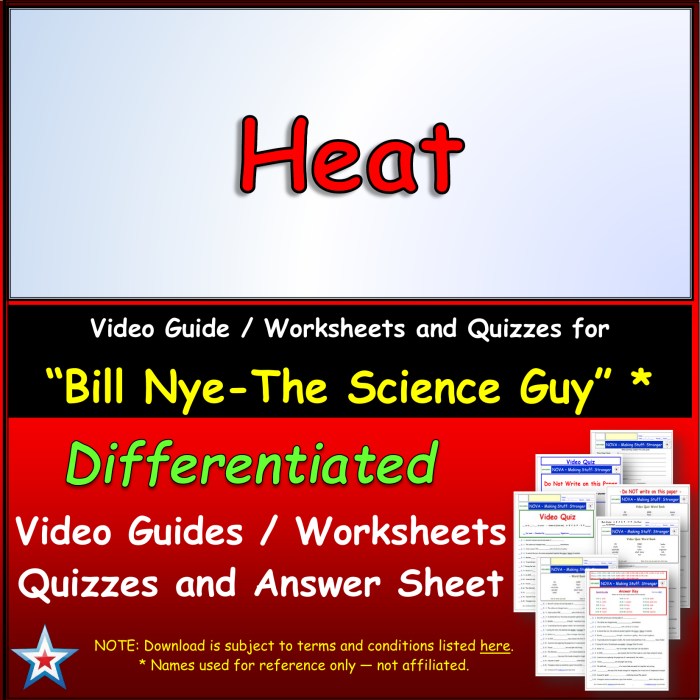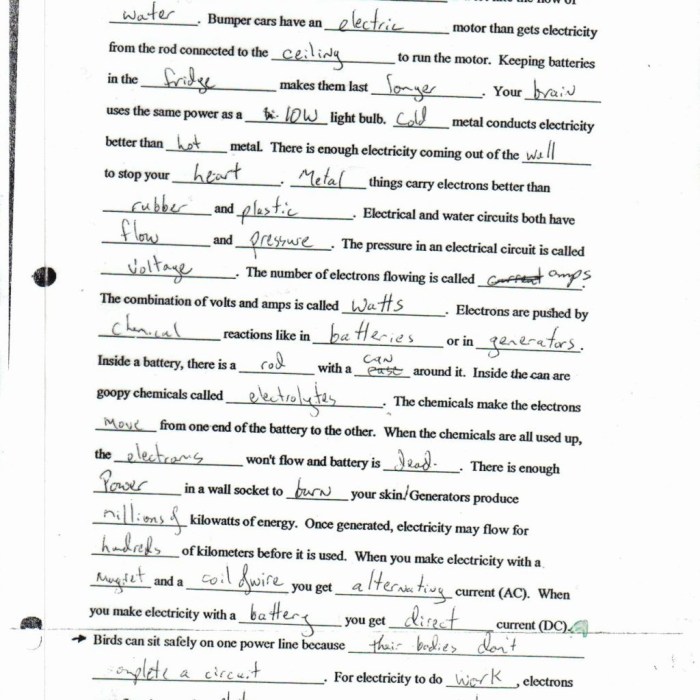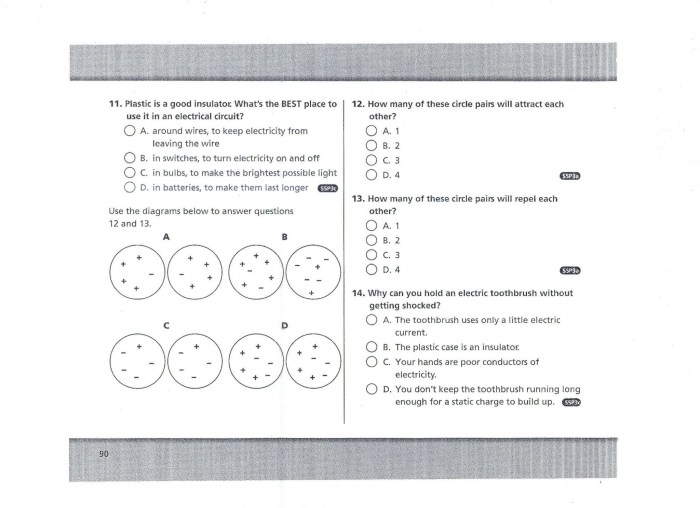Unveiling the intricacies of heat transfer, the Bill Nye Heat Video Worksheet Answer Key PDF serves as an invaluable resource for students seeking a deeper understanding of this fundamental scientific concept. This comprehensive guide delves into the multifaceted nature of heat transfer, exploring its various modes and applications across diverse fields.
Embarking on a journey through the realm of heat transfer, this worksheet delves into the mechanisms of conduction, convection, and radiation, unraveling their distinct characteristics and real-world examples. Thermal energy takes center stage, with its relationship to temperature and heat meticulously examined.
Specific heat capacity emerges as a crucial concept, enabling the calculation of heat required to alter a substance’s temperature. The practical applications of heat transfer are brought to life, showcasing its significance in engineering, medicine, and manufacturing.
Bill Nye Heat Video Worksheet

The Bill Nye Heat Video Worksheet is a resource designed to accompany the Bill Nye the Science Guy video on heat. The worksheet helps students to learn about the different modes of heat transfer, thermal energy, and specific heat capacity.
The worksheet includes a variety of questions and activities that help students to understand the concepts of heat transfer. These activities include:
- Defining the three modes of heat transfer: conduction, convection, and radiation.
- Explaining how each mode of heat transfer works.
- Providing examples of each mode of heat transfer in everyday life.
- Defining thermal energy.
- Explaining how thermal energy is related to temperature and heat.
- Discussing the different ways that thermal energy can be transferred.
- Defining specific heat capacity.
- Explaining how specific heat capacity is used to calculate the amount of heat required to raise the temperature of a substance.
- Providing examples of substances with different specific heat capacities.
Heat Transfer: Bill Nye Heat Video Worksheet Answer Key Pdf

Heat transfer is the movement of thermal energy from one object to another. There are three modes of heat transfer: conduction, convection, and radiation.
Conduction
Conduction is the transfer of heat through direct contact between two objects. For example, when you touch a hot stove, heat from the stove is transferred to your hand through conduction.
Convection, Bill nye heat video worksheet answer key pdf
Convection is the transfer of heat through the movement of a fluid. For example, when you boil water, heat from the bottom of the pot is transferred to the water through convection.
Radiation
Radiation is the transfer of heat through electromagnetic waves. For example, heat from the sun is transferred to the Earth through radiation.
Thermal Energy
Thermal energy is the energy associated with the movement of atoms and molecules. The higher the temperature of an object, the more thermal energy it has.
Thermal energy can be transferred from one object to another through conduction, convection, or radiation.
The amount of heat required to raise the temperature of an object by 1 degree Celsius is called the specific heat capacity of the object.
Specific Heat Capacity
Specific heat capacity is a measure of how much heat is required to raise the temperature of a substance by 1 degree Celsius.
The specific heat capacity of a substance is determined by its atomic structure and molecular bonding.
Substances with a high specific heat capacity require more heat to raise their temperature than substances with a low specific heat capacity.
Applications of Heat Transfer

Heat transfer is used in a variety of applications, including:
- Heating and cooling buildings
- Manufacturing
- Medicine
- Power generation
- Transportation
Heat Transfer Experiments
Conduction
To demonstrate conduction, you can perform the following experiment:
- Take two metal rods of different lengths.
- Heat one end of each rod with a flame.
- Observe how long it takes for the heat to travel to the other end of each rod.
You will find that the heat travels faster through the shorter rod than through the longer rod. This is because the shorter rod has less mass, so it requires less heat to raise its temperature.
Convection, Bill nye heat video worksheet answer key pdf
To demonstrate convection, you can perform the following experiment:
- Fill a beaker with water.
- Place a candle under the beaker.
- Observe how the water circulates in the beaker.
You will find that the water near the candle is heated first. This water then rises to the top of the beaker, and cooler water from the bottom of the beaker takes its place. This process continues until all of the water in the beaker is heated.
Radiation
To demonstrate radiation, you can perform the following experiment:
- Place a piece of paper in the sun.
- Observe how the paper gets warm.
The paper gets warm because it is absorbing radiation from the sun. Radiation is a form of electromagnetic energy that can travel through space without the need for a medium.
Key Questions Answered
What is the purpose of the Bill Nye Heat Video Worksheet?
The Bill Nye Heat Video Worksheet is designed to enhance students’ understanding of heat transfer concepts presented in the accompanying video.
What topics are covered in the Bill Nye Heat Video Worksheet?
The worksheet covers the three modes of heat transfer (conduction, convection, and radiation), thermal energy, and specific heat capacity.
How can I use the Bill Nye Heat Video Worksheet Answer Key PDF?
The answer key provides solutions to the worksheet questions, allowing students to check their understanding and identify areas for improvement.